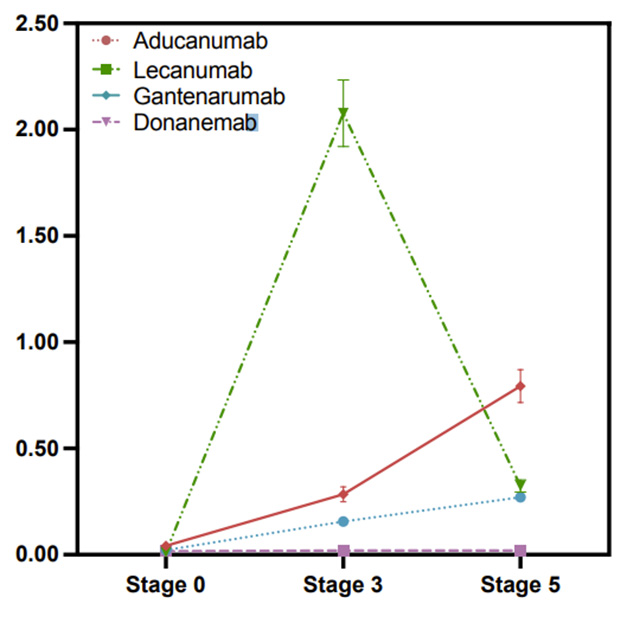Lecanemab Tops Other Antibodies at Binding Soluble Aβ Aggregates
Quick Links
Four anti-amyloid antibodies—lecanemab, aducanumab, gantenerumab, donanemab—cleared plaque from the brain in Phase 3 trials, but only two went on to receive traditional U.S. marketing approval. What distinguished the successful ones? In a preprint posted to bioRxiv on October 12, scientists led by David Klenerman at the University of Cambridge and Bart De Strooper at the UK Dementia Research Institute, University College London, offered some clues. They characterized each antibody’s ability to bind soluble Aβ aggregates in vitro, and found that lecanemab performed the best. Meanwhile, donanemab did not bind any soluble aggregates, confirming that its efficacy rests solely on clearing plaques. Surprisingly, both lecanemab and aducanumab bound pyroglutamine forms of Aβ.
Previously, Lars Lannfelt at Uppsala University, Sweden, who led development of lecanemab, reported the antibody bound Aβ protofibrils more strongly than did aducanumab or gantenerumab (Nov 2021 conference news). Lannfelt later compared lecanemab with donanemab, reporting that the two antibodies bound fibrillar amyloid peppered with pyroglutamate-Aβ equally well (Nov 2023 conference news). Donanemab was designed to target this truncated, sticky form of Aβ, which deposits readily.

Lecanemab Favors Early Aggregates. Fluorescently labeled lecanemab (green) bound most strongly to soluble Aβ aggregates isolated from Braak stage III brains, while aducanumab (red) preferred stage V aggregates, which are presumably larger. Donanemab (purple) did not bind any soluble species. [Courtesy of Fertan et al., bioRxiv.]
Klenerman and colleagues set out to compare all four antibodies head-to-head in the same assays. Joint first authors Emre Fertan and Jeff Lam at Cambridge used single-molecule arrays and super-resolution microscopy to visualize the signals from labeled antibodies. They first assessed binding of synthetic Aβ42 monomers conjugated to silica nanoparticles. Lecanemab had the highest sensitivity, detecting as little as 2 pM, while limit of detection (LoD) for gantenerumab was 70 pM, for aducanumab 200 pM, and, as expected, donanemab did not bind. For pyroGlu-Aβ monomers, LoDs were 4 pM, 5 pM, and 56 pM for lecanemab, donanemab, and aducanumab, while gantenerumab did not bind. Lecanemab and aducanumab had not previously been reported to bind pyroGlu-Aβ.
The authors then aggregated Aβ42 or pyroGlu-Aβ in vitro, resulting in clusters that ranged from 100 to 125 nm in length, making them protofibrils. For Aβ42 protofibrils, lecanemab again had the highest affinity, detecting 2 pM. Aducanumab was at 63, while neither gantenerumab nor donanemab bound these species. PyroGlu-Aβ could only form aggregates in association with Aβ42, and the same pattern of affinities held for these mixed Aβ42/pyroGlu-Aβ aggregates, with lecanemab binding most strongly and neither gantenerumab nor donanemab recognizing them. The fact that donanemab did not bind clumped pyroGlu-Aβ suggests its binding region might be buried in the aggregate and inaccessible, the authors noted.
To test natural material, the authors isolated soluble Aβ aggregates from postmortem samples of Braak stage 0, III, or V brains. None of the antibodies bound well to stage 0 extracts, suggesting few Aβ oligomers were present. At stage 3, lecanemab bound much more strongly than did aducanumab or gantenerumab, in keeping with its affinity for smaller protofibrils. At stage V, aducanumab bound the most strongly of the three, suggesting a preference for larger aggregates. Curiously, donanemab did not bind soluble aggregates from brain at any stage, again suggesting its binding epitope was unavailable (image above).
The data may help explain lecanemab’s therapeutic success, the authors suggested. They noted that for donanemab, additional studies of plaque binding will be needed to elucidate its mechanism of action.—Madolyn Bowman Rogers
References
Therapeutics Citations
News Citations
Further Reading
Primary Papers
- Fertan E, Lam JY, Albertini G, Dewilde M, Wu Y, Akingbade OE, Boeken D, English EA, DeStrooper B, Klenerman D. Single-molecule characterisation of soluble beta-amyloid aggregate binding by Aducanumab, Lecanemab, Gantenerumab, and Donanemab. 2024 Oct 12 10.1101/2024.10.11.617910 (version 1) bioRxiv.
Annotate
To make an annotation you must Login or Register.

Comments
No Available Comments
Make a Comment
To make a comment you must login or register.